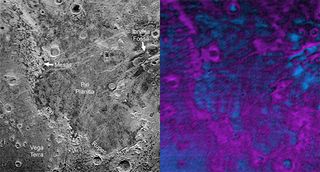What Bit a Chunk Out of Pluto's Ice?

Pluto has proven itself to be a diverse, dynamic and fascinating world packed with strange phenomena that planetary scientists are having problems fully explaining. And now they've found an icy oddity that highlights one of the key processes that is believed to shape this dwarf planet's surprisingly young surface.
PHOTOS: Dive Onto Pluto's High-Resolution Landscape
In recent high-resolution images sent back to Earth from NASA's New Horizons mission, which buzzed Pluto on July 14, 2015, a rather obvious chunk of ice appears to have been ripped away from Pluto’s surface. The upper layers of methane ice are missing from a western plain called Piri Planitia, a feature that is enriched with water ice.
Below Piri Planitia is a very old cratered terrain called Vega Terra, which is separated from the young plain by a series of cliffs (or "scarps"). Some of these scarps appear to have broken off, creating isolated hills (or "mesas"). But what has caused this discontinuity? Why has the methane ice-rich surface layers been cut off by the cliffs, giving way to a lowland plain rich in water ice?
ANALYSIS: 'X' Marks the Convective Spot on 'Lava Lamp' Pluto
According to mission scientists, the answer probably lies in how various ices in extreme environments react to being heated.

As we can probably guess, Pluto is a cold place. Though it's frozen, it is far from static. Chemicals that would normally be in a gas or liquid state here on Earth become solid layers of ice on Pluto. When the world receives even the tiniest amount of heating, volatiles — such as methane or ammonia ice — sublimate.
Get the Space.com Newsletter
Breaking space news, the latest updates on rocket launches, skywatching events and more!
Sublimation occurs when the atmospheric pressure or temperature (or both) are very low. Water ice, for example, at sea level pressures on Earth will melt into a liquid and then boil into a vapor (or gas) when heated. On Pluto, because it's so cold and the pressures are a near vacuum, liquid water is not possible and heated water ice will sublimate directly from a solid into a gas. And it appears that's what's happening with the methane ice in Piri Planitia; it's sublimating into Pluto's thin atmosphere, likely contributing to the dwarf planet's atmospheric cycles of surface ices and exposing water ice-rich layers below.
NEWS: Pluto's Weirdly Young Surface Doesn't Make Sense
It's almost as if Pluto is getting a rejuvenating facial scrub; over millions of years, as its surface is gently heated by our distant sun, the surface layers of ice are sublimated away, creating young-looking regions curiously free of ancient impact craters.
Originally published on Discovery News.
Join our Space Forums to keep talking space on the latest missions, night sky and more! And if you have a news tip, correction or comment, let us know at: community@space.com.
Ian O'Neill is a media relations specialist at NASA's Jet Propulsion Laboratory (JPL) in Southern California. Prior to joining JPL, he served as editor for the Astronomical Society of the Pacific‘s Mercury magazine and Mercury Online and contributed articles to a number of other publications, including Space.com, Space.com, Live Science, HISTORY.com, Scientific American. Ian holds a Ph.D in solar physics and a master's degree in planetary and space physics.
